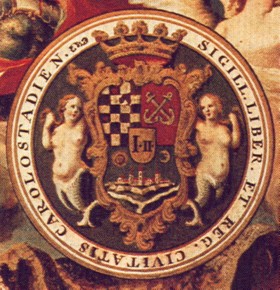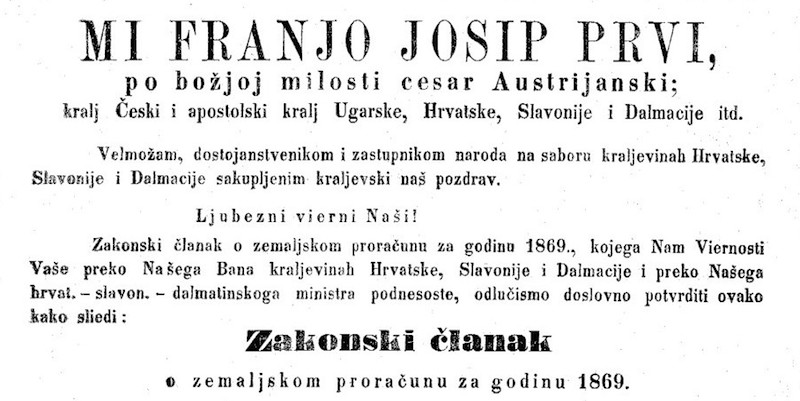Kingdom of Croatia in Austria-Hungary and
Croatian Military Frontier
The expresson "K. und K." (or just "K. K.", i.e., "Kaiserliche und Königliche", that is, "Imperial and Royal") refers to Austrian emperor, who was also the king of Hungary as well as of other kingdoms in Austria-Hungary, including Croatian Kingdom. Here, we should not forget that Croatia, along with Slavonia, at the time of Tesla's schooling had the status of kingdom, which was in personal union with Hungary, called Hungarian-Croatian Kingdom. The above mentioned "Royal Land Government (Kraljevska zemaljska vlada) in Zagreb" ruled Croatian Kingdom by means of one or more viceroys (called "Bans" in Croatian language; singular: "Ban"). During Tesla's schooling in Rakovac (1870-1873), there were four Croatian Bans (viceroys) in Zagreb:
- 1868 – 1871: Baron Levin Rauch de Nyék
- 1871 – 1872: Koloman pl. Bedeković de Komor (Bedeković Komorski); here pl. (plemeniti) - noble
- 1872 – 1873: Antun pl. Vukanović
- 1873 – 1880: Ivan Mažuranić.
In 1868, the Croatian–Hungarian Settlement was signed by the Hungarian Parliament and the Croatian Sabor. The Kingdom of Slavonia was incorporated into Croatia; the Kingdom of Croatia-Slavonia was established as an autonomous state within Hungary.
Since 1867, the full official title of Emperor Francic Joseph I was the following (translated from the German language):
His Imperial and Royal Apostolic Majesty,
By the Grace of God Emperor of Austria ,
King of Hungary and Bohemia, Dalmatia, Croatia, Slavonia, Galicia, Lodomeria and Illyria;
King of Jerusalem, etc.;
Archduke of Austria;
Grand Duke of Tuscany and Cracow;
Duke of Lorraine, Salzburg, Styria, Carinthia, Carniola and Bukovina;
Grand Prince of Transylvania, Margrave of Moravia;
Duke of Upper and Lower Silesia, of Modena, Parma, Piacenza and Guastalla, of Auschwitz and Zator,
of Teschen, Friaul, Ragusa and Zara;
Princely Count of Habsburg and Tyrol, of Kyburg, Gorizia and Gradisca;
Prince of Trent and Brixen;
Margrave of Upper and Lower Lusatia and in Istria;
Count of Hohenems, Feldkirch, Bregenz, Sonnenberg etc.;
Lord of Trieste, of Cattaro and on the Windic March;
Grand Voivode of the Voivodeship of Serbia
etc., etc.
In 1881, the Croatian Military Frontier was incorporated into the Kingdom of Croatia-Slavonia.
In 1883, Croatian parliamentary by-elections were organized. The first day of elections to the Sabor (Croatian Parliament in Zagreb) included the former territories of the Croatian Military Frontier. More inforamtion at the Timeline of Croatian History.

The complete German name of the Higher Real School in Rakovac, attended by young Nikola Tesla, was Kaiserlich-königliche Ober-realschule in Rakovac in der k.k. kroatischen Militärgrenze.
The Emperor and King Francis Joseph I, when he ordered the decisions and laws referring to a particular kingdom, then he was entitled accrodingly. As an example, we provide a law from 1868, published in 1870, written in Croatian language:
WE FRANCIS JOSEPH THE FIRST,
according to God's mercy Austrian Emperor;
Bohemian King and the Apostolic King of Hungary, Croatia, Slavonia and Dalmatia etc.

(izvor ALEX Historische Rechts- und Gesetzestexte Online)
Literature
- Školovanje Nikole Tesle u Hrvatskoj i njegov učitelj Martin Sekulić
- Nikola Tesla: My Inventions (on the left page, on the left of the photo of induction motor, there is a description of his ingenious profesor of Physics from Karlovac (Martin Sekulić)
- Mirjana Gross and Agneza Szabo: Prema hrvatskome građanskom društvu, Zagreb, 1992. (suggested as a basic reference for political and social situation in Croatia by Željko Holjevac, PhD.
- Mirko Valentić: Vojna krajina i pitanje njezina sjedinjenja s Hrvatskoj 1849-1881, Zagreb 1981. (basic historiographic worka about Croatian-Slavonian Military Frontier, suggested by Željko Holjevac, PhD.)